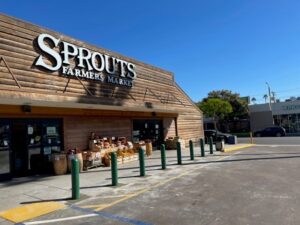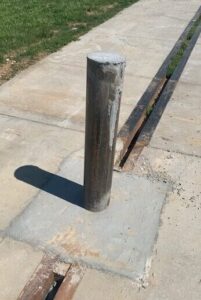
Average reading time: 5 minutes
At Barrier1 Systems, we have nearly 20 years of proven experience engineering and manufacturing innovative perimeter security solutions. As a certified GSA contract holder with products tested to ASTM standards and a history of innovation that includes more than a dozen patented technologies, we know what goes into building reliable protection.
Safety bollards play a key role in reducing risk from vehicle intrusions—but not everyone knows where to start when choosing or buying them. In this guide, we’ll walk you through where to buy safety bollards, what to look for in terms of quality, and how to select the best option for your project.
The Differences Between Safety and High-Security Bollards
Safety bollards are vertical posts made from strong materials that are designed to protect people, property, and equipment from accidental vehicular impacts. These bollards differ from high-security bollards in that they are intended to protect against low-speed collisions, such as those that occur when a driver loses control of a vehicle. High-security bollards, on the other hand, protect against both accidental and intentional impacts that occur at faster speeds and in potentially higher vehicle weight classes.
In 2024, there was an estimated $141 billion in property damage from vehicle collisions, and safety bollards can help mitigate the damage that slow-moving vehicles can cause to storefronts or pedestrians. With these in place, a safety bollard not only provides protection but also serves as a deterrent.
In areas like parking lots or sidewalk-adjacent storefronts, safety bollards are essential for guiding both vehicles and pedestrians while physically deterring cars from entering pedestrian-only areas. This is essential in areas where pavement levels are nearly flush. Safety bollards help prevent accidental intrusions in this way by reinforcing safe boundaries and providing a visible guidepost.
| Safety Bollards | High-Security Bollards |
|---|---|
| Designed to protect from slower-moving impacts (10, 20, and 30 mph) | Designed to protect against impacts at higher speeds (30, 40, and 50 mph) |
| Tested with surrogate test vehicles that weigh 5,000 lbs. | Tested with medium-duty vehicles weighing up to 15,000 lbs. |
| Penetration ratings start at a P1 level, meaning the test vehicle’s intrusion is limited to one foot beyond the safety bollard after impact. | Penetration ratings start at a P1 level, meaning the test vehicle’s intrusion is limited to less than 3.3 feet (1 meter) beyond the bollard after impact. |
Where to Buy Safety Bollards
When purchasing safety bollards, where you buy from matters just as much as what you buy. Choosing the right source can impact durability, performance, and safety compliance. Whether you’re considering an online retailer, a local distributor, or buying directly from the manufacturer, it’s important to weigh the pros and cons of each to ensure long-term safety and value.
Online Retailer
| Pros | Cons |
|---|---|
|
|
Local Distributor
| Pros | Cons |
|---|---|
|
|
Direct from Manufacturer
| Pros | Cons |
|---|---|
|
|
Our Safety Bollards
At Barrier1 Systems, our safety bollards include these two models.
Tomcat S10 Storefront Safety Bollard

Features and Benefits:
- ASTM Crash Rating: S10-P1 per the ASTM F-3016-19 standard
- Ideal for convenience stores, banks, retail locations, and sidewalks where pedestrian safety is a concern.
- Innovative core drill installation.
- Easily retrofit existing store and public areas.
- A variety of aesthetically pleasing covers are available.
- Removable Bollard available as an option.
- No rebar in the bollard or foundation.
- Same day excavation and installation.
Tomcat Traffic Impact Bollard

Features and Benefits:
- Engineered and independently crash tested to stop a 2,430lb vehicle traveling at 40mph.
- Ideal for downtown public areas, retail storefronts, and restaurants.
- Does not require foundational rebar and is designed for easy retrofitting with same-day excavation and installation.
- Designed and manufactured in the USA.
Determining Which Are the Best High-Quality Safety Bollards
Construction: High-quality safety bollards are typically constructed from durable materials like stainless or carbon steel. Both of these materials offer long-term strength and corrosion resistance for the bollard. Some models may also be filled with concrete to increase mass and impact resistance.
Crash Rating: Crash ratings indicate how well a bollard can stop an oncoming vehicle. Safety bollards are commonly tested under the ASTM F3016 standard, which evaluates their ability to stop a vehicle under 5,000 lbs. traveling at lower speeds. The higher the rating, the more protection the bollard offers against vehicle intrusion. To meet recognized safety standards, bollards must undergo testing and perform within specified penetration limits.
The Installation: Safety bollard installation typically requires a set-and-pour installation method. This means that the bollard will need a foundation depth of more than two feet for stability. While there are bollards with a shallow mount design (typically starting at an excavation of one foot), these are typically high-security bollards. For example, our two safety bollard models, the Tomcat S10 Storefront Safety Bollard and the Tomcat Traffic Impact Bollard, require foundation depths of 43 inches and 30 inches, respectively.
Our Tomcat S10 bollard can be installed using a 12-inch core drill when placing it in areas with existing concrete or sidewalk. This method involves drilling a 12-inch diameter hole to a depth of 43 inches, then setting the bollard in place on a 1-inch masonry block at the base of the footing. Once the bollard is level, the hole is filled with 3,000 PSI concrete to complete the foundation and ensure impact resistance in accordance with ASTM F3016 standards.
For the Tomcat Traffic Impact Bollard (TIB), there’s a five-step process for installation:
- Excavate, then tamp the subgrade with a plate tamper/compactor so that the soil is compressed.
- Use masonry block or chairs to elevate the bollard off the subgrade so that the top of the gusset/sleeve is the same height as the top of the concrete.
- Place the prefabricated bollards into the excavation.
- Insert vertical rebar into the bollard tube.
- Fill the bollard tube and excavation with 4,000 psi concrete.
Leave Safety and Security to Barrier1
Barrier1 is here to protect businesses and the pedestrians who frequent them. Trust our safety bollards to provide a shield from vehicular mishap. Have questions or need help selecting the right solution for your site? Give us a call at (336) 617-8478 or email us at info@barrier1.com today!
